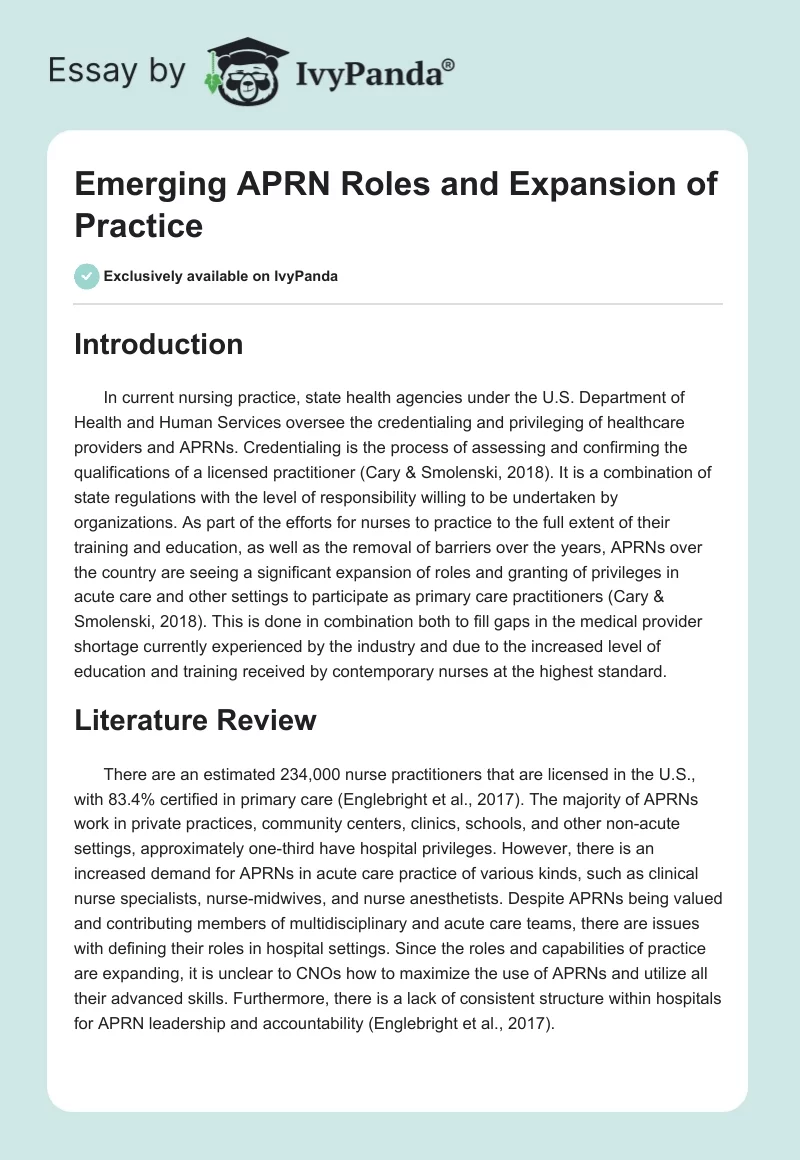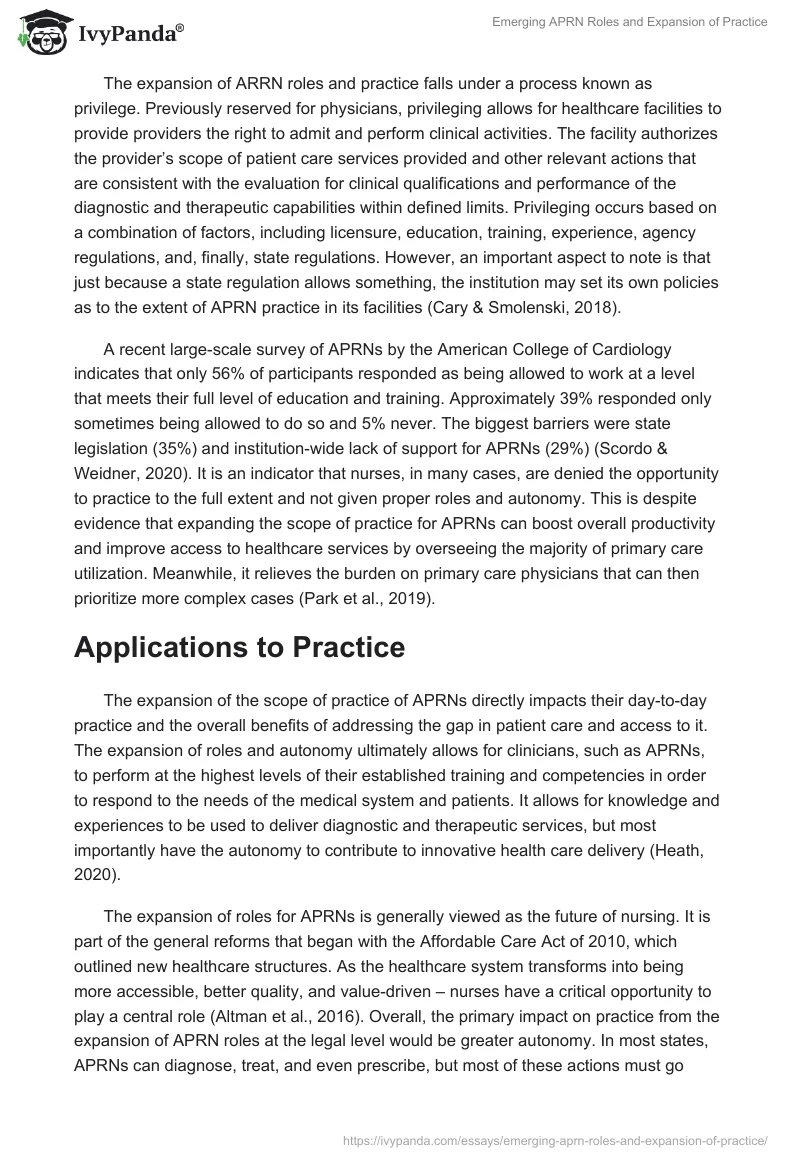Introduction
In current nursing practice, state health agencies under the U.S. Department of Health and Human Services oversee the credentialing and privileging of healthcare providers and APRNs. Credentialing is the process of assessing and confirming the qualifications of a licensed practitioner (Cary & Smolenski, 2018). It is a combination of state regulations with the level of responsibility willing to be undertaken by organizations.
As part of the efforts for nurses to practice to the full extent of their training and education, as well as the removal of barriers over the years, APRNs over the country are seeing a significant expansion of roles and granting of privileges in acute care and other settings to participate as primary care practitioners (Cary & Smolenski, 2018). This is done in combination both to fill gaps in the medical provider shortage currently experienced by the industry and due to the increased level of education and training received by contemporary nurses at the highest standard.
Literature Review
There are an estimated 234,000 nurse practitioners that are licensed in the U.S., with 83.4% certified in primary care (Englebright et al., 2017). The majority of APRNs work in private practices, community centers, clinics, schools, and other non-acute settings, approximately one-third have hospital privileges. However, there is an increased demand for APRNs in acute care practice of various kinds, such as clinical nurse specialists, nurse-midwives, and nurse anesthetists. Despite APRNs being valued and contributing members of multidisciplinary and acute care teams, there are issues with defining their roles in hospital settings. Since the roles and capabilities of practice are expanding, it is unclear to CNOs how to maximize the use of APRNs and utilize all their advanced skills. Furthermore, there is a lack of consistent structure within hospitals for APRN leadership and accountability (Englebright et al., 2017).
The expansion of ARRN roles and practice falls under a process known as privilege. Previously reserved for physicians, privileging allows for healthcare facilities to provide providers the right to admit and perform clinical activities. The facility authorizes the provider’s scope of patient care services provided and other relevant actions that are consistent with the evaluation for clinical qualifications and performance of the diagnostic and therapeutic capabilities within defined limits. Privileging occurs based on a combination of factors, including licensure, education, training, experience, agency regulations, and, finally, state regulations. However, an important aspect to note is that just because a state regulation allows something, the institution may set its own policies as to the extent of APRN practice in its facilities (Cary & Smolenski, 2018).
A recent large-scale survey of APRNs by the American College of Cardiology indicates that only 56% of participants responded as being allowed to work at a level that meets their full level of education and training. Approximately 39% responded only sometimes being allowed to do so and 5% never. The biggest barriers were state legislation (35%) and institution-wide lack of support for APRNs (29%) (Scordo & Weidner, 2020). It is an indicator that nurses, in many cases, are denied the opportunity to practice to the full extent and not given proper roles and autonomy. This is despite evidence that expanding the scope of practice for APRNs can boost overall productivity and improve access to healthcare services by overseeing the majority of primary care utilization. Meanwhile, it relieves the burden on primary care physicians that can then prioritize more complex cases (Park et al., 2019).
Applications to Practice
The expansion of the scope of practice of APRNs directly impacts their day-to-day practice and the overall benefits of addressing the gap in patient care and access to it. The expansion of roles and autonomy ultimately allows for clinicians, such as APRNs, to perform at the highest levels of their established training and competencies in order to respond to the needs of the medical system and patients. It allows for knowledge and experiences to be used to deliver diagnostic and therapeutic services, but most importantly have the autonomy to contribute to innovative health care delivery (Heath, 2020).
The expansion of roles for APRNs is generally viewed as the future of nursing. It is part of the general reforms that began with the Affordable Care Act of 2010, which outlined new healthcare structures. As the healthcare system transforms into being more accessible, better quality, and value-driven – nurses have a critical opportunity to play a central role (Altman et al., 2016). Overall, the primary impact on practice from the expansion of APRN roles at the legal level would be greater autonomy. In most states, APRNs can diagnose, treat, and even prescribe, but most of these actions must go through a physician for approval. The ANA fully supports that APRNs be granted full practice authority upon licensure and certification. In turn, with autonomy and recognition of expanded roles, there will arise greater opportunities for leadership, independent practice, and advocacy on behalf of nurses (Kleinpell, 2020).
There is a major benefit in terms of multidisciplinary teams, as well as there is an increased demand for the integration of APRNs as part of interprofessional teams, and such will continue to grow as APRN roles expand. This is due to the number of complex care patients requiring comprehensive management. Management of complex patients warrants communication, care coordination, discharge planning, and administrative work, where APRNs and NPs are highly familiar with such tasks and can competently aid the multidisciplinary teams (Woo et al., 2017). Nurses can also provide and utilize skills and expertise in specific acute settings, nurse anesthesiologist being one potential role, but others can follow in the complexity of healthcare settings in the future.
Real-Life Examples
While a significant focus of expanded APRN roles is on filling the primary care gap or nursing autonomy for independent practice, the scope is broader. In acute care settings, APRNs can provide high-level care within the context of interdisciplinary collaboration. In fact, NPs can be facilitators, according to nurses at the UCSF Medical Center. APRNs understand the continuum of care while having good relationships with all levels of staff. They contribute to patient care, particularly in the form of facilitating communication among relevant parties and creating a care plan. They also create efficiencies in acute care by bridging gaps between less and greater complexity of care among hospital services or overseeing the challenging transition of inpatient and outpatient care (Austin, 2016).
Another relevant example came during the midst of the COVID-19 pandemic. Several states issued executive orders which temporarily suspended or waived APRN practice requirements, essentially allowing for significant autonomy of practice and highly expanded roles for these frontline health workers. As a result, it allowed recognition of the capabilities and impact of APRNs in the healthcare system. APRNs led community testing centers, coordinated COVID-19 response, conducted home visits, and managed telehealth services for patients, among others. Expansion of role allowed to meet current or project clinical needs, ensuring the leadership of mid and low-level medical personnel, and providing opportunities for NPs to serve in administrative roles in order to promote the supportive structure (Kleinpell, 2020).
Challenges and Proposed Changes
While there are seemingly multiple benefits to APRN role expansion, there are also challenges regarding the integration and advancement of APRNs. First, there is the potential challenge of safety, which is the primary reason why many jurisdictions have not granted nurses full autonomy. With the current system in place, there is a supporting and ‘defensive’ mechanism in place, which helps to protect patient safety by a more experienced and educated physician. There are also beliefs that the expansion of autonomy will result in the emergence of siloed care, with individual APRNs treating the patients rather than whole teams since nurses will be able to essentially develop care plans and prescribe medication on their own (Robeznieks, 2020).
The issue of costs is applicable both to patients and to organizations. Patients may be affected by cost because, with expanded roles, nurses will prescribe more tests, medications, and other aspects. Meanwhile, institutions may see a perceived higher expense of hiring and training APRNs as well as likely increasing salaries due to bigger responsibilities under new roles (Kleinpell et al., 2020).
One of the major proposed changes is to integrate clinical metrics to have a clear perspective of objective APRN contributions to a specific healthcare organization. These will provide insight on whether role expansion is warranted further, as well as help in conducting a cost-benefit analysis for hiring and training new APRNs. Another proposed change is integrating a structured system of transition and support for APRNs. This will aim to offer professional guidance in the context of the complexity of care and newfound roles and autonomy, guiding nurses towards interprofessional collaboration, leadership, and competent patient care.
References
Altman, S.H., Butler, A.S., & Shern, L. (eds.). (2016). Assessing progress on the Institute of Medicine report ‘The Future of Nursing.’National Academies Press. Web.
Austin, D. (2016). New roles for nurse practitioners bring opportunities and challenges. Science of Caring. Web.
Cary, A. H., & Smolenski, M. C. (2020). Credentialing and clinical privileges for the advanced practice registered nurse. In L.A. Joel (Ed.), Advanced practice nursing: Essentials for role development (4th ed.). F.A. Davis Company.
Englebright, J., McCurley, J., & Borum, C. (2017). The emerging role of APRNs in hospital nursing practice: Perspectives from a survey of chief nursing officers. Nurse Leader, 15(6), 387–391. Web.
Heath, S. (2020). Making the case for expanded nurse practitioner scope of practice. PatientEngagementHIT. Web.
Kleinpell, R.M., Kapu, A.N., Stempek, S., Sicoutris, C., Broyhill, B.S., & D’Agostino, R. (2020). Developing and expanding APRN and PA teams.American Nurse. Web.
Park, J., Han, X., & Pittman, P. (2019). Does expanded state scope of practice for nurse practitioners and physician assistants increase primary care utilization in community health centers? Journal of the American Association of Nurse Practitioners, 32(6), 1. Web.
Robeznieks, A. (2020). Why expanding APRN scope of practice is bad idea. AMA. Web.
Scordo, K. A., & Weidner, C. H. (2020). The emerging role of advanced practice registered nurses in cardiology: Insights from the ACC APRN survey.Cardiology Magazine. Web.
Woo, B. F. Y., Lee, J. X. Y., & Tam, W. W. S. (2017). The impact of the advanced practice nursing role on quality of care, clinical outcomes, patient satisfaction, and cost in the emergency and critical care settings: a systematic review.Human Resources for Health, 15(1). Web.


